Punjab State Board PSEB 12th Class Maths Book Solutions Chapter 10 Vector Algebra Ex 10.3 Textbook Exercise Questions and Answers.
PSEB Solutions for Class 12 Maths Chapter 10 Vector Algebra Ex 10.3
Question 1.
Find the angle between two vectors \(\vec{a}\) and \(\vec{b}\) with magnitudes √3 and 2, respectively, having \(\vec{a}\) . \(\vec{b}\) = √6.
Solution.
It is given that, |\(\vec{a}\)| = √3, |\(\vec{b}\)| = 2 and
\(\vec{a}\) . \(\vec{b}\) = √6
∴ √6 = √3 × 2 × cos θ
⇒ cos θ = \(\frac{\sqrt{6}}{\sqrt{3} \times 2}\)
⇒ cos θ = \(\frac{1}{\sqrt{2}}\)
⇒ θ = \(\frac{\pi}{4}\)
Hence, the angle between the given vectors \(\vec{a}\) and \(\vec{b}\) is \(\frac{\pi}{4}\).
Question 2.
Find the angle between the vectors î – 2 ĵ + 3k̂ and 3 î – 2 ĵ + k̂.
Solution.
The given vectors are \(\vec{a}\) = î – 2 ĵ + 3k̂ and \(\vec{b}\) = 3 î – 2 ĵ + k̂
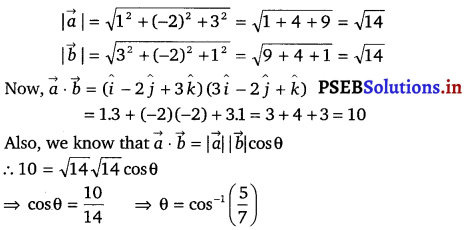
![]()
Question 3.
Find the projection of the vector î – ĵ on the vector î + ĵ.
Solution.
Let \(\vec{a}\) = î – ĵ and \(\vec{b}\) = î + ĵ
Now, projection of vector a on S is given by
\(\frac{1}{|\vec{b}|}(\vec{a} \cdot \vec{b})=\frac{1}{\sqrt{1+1}}\{1.1+(-1)(1)\}=\frac{1}{\sqrt{2}}(1-1)=0\)
Hence, the projection of vector \(\vec{a}\) and \(\vec{b}\) is 0.
Question 4.
Find the projection of the vector î + 3ĵ + k̂ on the vector 7î – ĵ + 8k̂.
Solution.
Let \(\vec{a}\) = i + 3j + 7k and \(\vec{b}\) = 7i – j + 8k
Now, projection of vector a and b is given by
\(\frac{1}{|\vec{b}|}(\vec{a} \cdot \vec{b})=\frac{1}{\sqrt{7^{2}+(-1)^{2}+8^{2}}}\{1(7)+3(-1)+7(8)\}\)
= \(\frac{7-3+56}{\sqrt{49+1+64}}=\frac{60}{\sqrt{114}}\)
Question 5.
Show that each of the given three vectors is a unit vector \(\frac{1}{7}\) (2î + 3ĵ + 8k̂), \(\frac{1}{7}\) (3î- 6ĵ + 2k̂), \(\frac{1}{7}\) (6î + 2k̂ – 3k̂)
Also, show that they are mutually perpendicular to each other.
Solution.
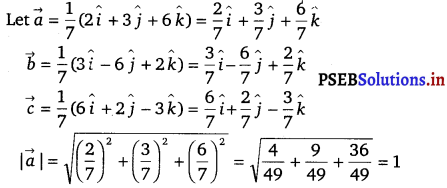
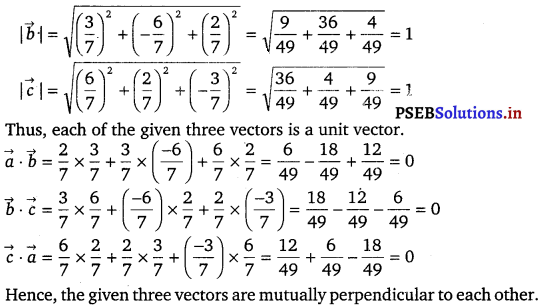
![]()
Question 6.
Find |\(|\overrightarrow{\boldsymbol{a}}|\)| and |\(|\overrightarrow{\boldsymbol{b}}|\)|, if \((\vec{a}+\vec{b}) \cdot(\vec{a}-\vec{b})\) = 8 and \(|\vec{a}|=8|\vec{b}|\).
Solution.
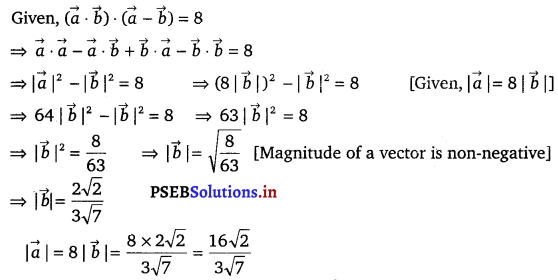
Question 7.
Evaluate the product \((3 \vec{a}-5 \vec{b}) \cdot(2 \vec{a}+7 \vec{b})\).
Solution.

Question 8.
Find the magnitude of two vectors \(\overrightarrow{\boldsymbol{a}}\) and \(\overrightarrow{\boldsymbol{b}}\) having the same magnitude and such that the angle between them is 60° and their scalar product is \(\frac{1}{2}\).
Solution.
Let θ be the angle between the vectors \(\overrightarrow{\boldsymbol{a}}\) and \(\overrightarrow{\boldsymbol{b}}\)
It is given that |\(\overrightarrow{\boldsymbol{b}}\)| = |\(\overrightarrow{\boldsymbol{b}}\)|, \(\overrightarrow{\boldsymbol{a}}\) . \(\overrightarrow{\boldsymbol{b}}\) = \(\frac{1}{2}\) and θ = 60°
We know that \(\overrightarrow{\boldsymbol{a}}\) . \(\overrightarrow{\boldsymbol{b}}\) = |\(\overrightarrow{\boldsymbol{a}}\) . \(\overrightarrow{\boldsymbol{b}}\)| cos θ

![]()
Question 9.
Find |\(\vec{x}\)|, if for a unit vector \(\vec{a}\), (\(\vec{x}\) – \(\vec{a}\)) . (\(\vec{x}\) + \(\vec{a}\)) = 12.
Solution.

Question 10.
If \(\vec{a}\) = 2î + 2 ĵ + 3k̂, \(\vec{b}\) = – î + 2 ĵ + k̂ and \(\vec{c}\) = 3î + ĵ are such that \(\vec{a}\) + \(\vec{b}\) is perpendicular to \(\vec{c}\), then find the value of λ.
Solution.
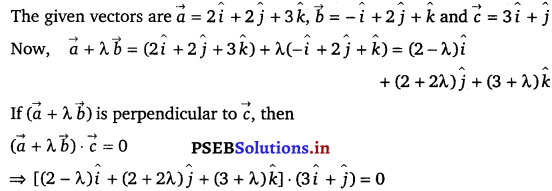
⇒ (2 – λ)3 + (2 + 2λ)1 + (3 + λ)0 = 0
⇒ 6 – 3λ + 2 + 2λ = 0
⇒ – λ + 8 = 0
⇒ λ = 8
Hence, the required value of λ is 8.
![]()
Question 11.
Show that |\(\vec{a}\)| \(\vec{b}\) + |\(\vec{b}\)| \(\vec{a}\) is perpendicular to |\(\vec{a}\)| \(\vec{b}\) – |\(\vec{b}\)| \(\vec{a}\), for any two non-zero vectors a and b.
Solution.

Question 12.
If \(\vec{a}\) . \(\vec{a}\) = 0 and \(\vec{a}\) . \(\vec{b}\) = 0, then what can be concluded about the vector 6?
Solution.

![]()
Question 13.
If \(\vec{a}\), \(\vec{a}\), \(\vec{c}\) are unit vectors such that \(\vec{a}\) + \(\vec{a}\) + \(\vec{c}\) = 0, find the value of \(\vec{a}\) . \(\vec{b}\) + \(\vec{b}\) . \(\vec{c}\) + \(\vec{c}\) . \(\vec{a}\).
Solution.
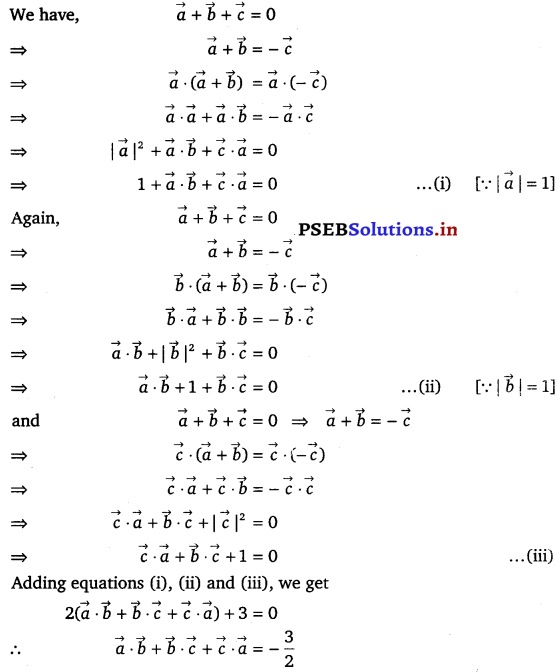
![]()
Question 14.
If either vector \(\vec{a}=\overrightarrow{0}\) or \(\overrightarrow{\boldsymbol{b}}=\overrightarrow{\mathbf{0}}\), then \(\overrightarrow{\boldsymbol{a}} \cdot \overrightarrow{\boldsymbol{b}}\) = 0. But the converse need not be true. Justify your answer with an example.
Solution.
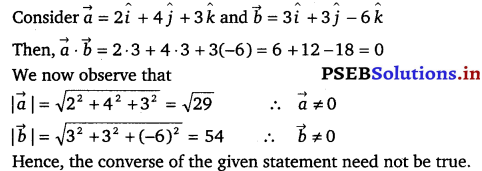
Question 15.
If the vertices A, B, C of a triangle ABC are (1, 2, 3), (- 1, 0, 0), (0, 1, 2), respectively, then find ∠ABC [∠ABC is the angle
between the vector \(\overrightarrow{\boldsymbol{B A}}\) and \(\overrightarrow{\boldsymbol{B C}}\)].
Solution.
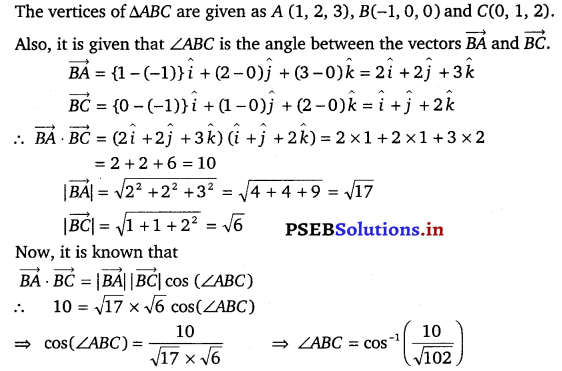
![]()
Question 16.
Show that the points A(1, 2, 7), B(2, 6, 3) and C(3, 10, – 1) are collinear.
Solution.
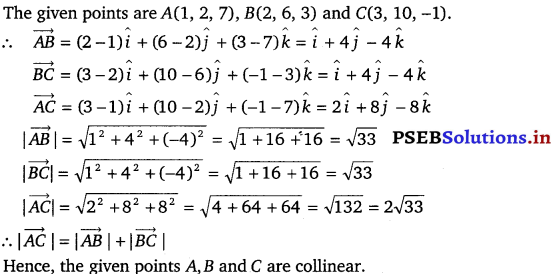
Question 17.
Show that the vectors 2î – ĵ + k̂, î – 3ĵ – 5k̂ and 3î – 4ĵ – 4k̂ form the vertices of a right angled triangle.
Solution.

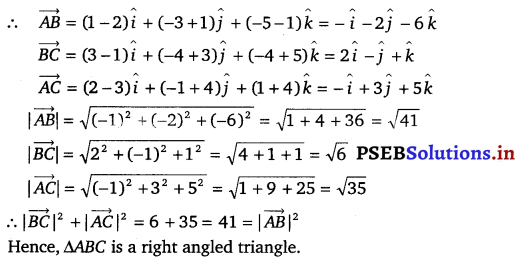
Question 18.
If \(\overrightarrow{\boldsymbol{a}}\) is a non-zero vector of magnitude ‘a’ and λ, is a non-zero scalar, then λ \(\overrightarrow{\boldsymbol{a}}\) is unit vector if
(A) λ = 1
(B) λ = – 1
(C) a = |λ|
(D) a = \(\frac{1}{|\lambda|}\)
Solution.

Hence, vector λ \(\overrightarrow{\boldsymbol{a}}\) is a unit vector if a = \(\frac{1}{|\lambda|}\).
The correct answer is (D).
